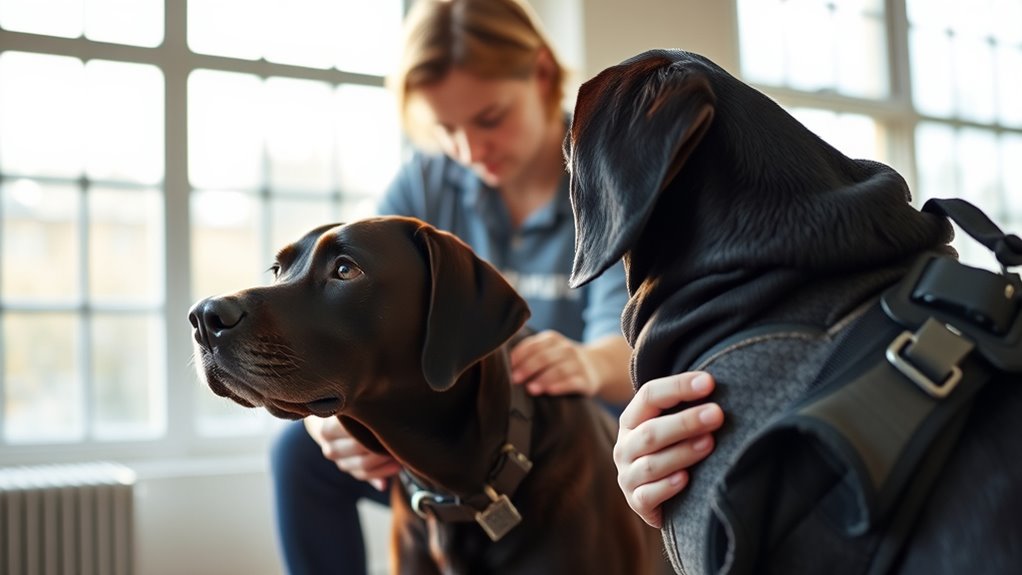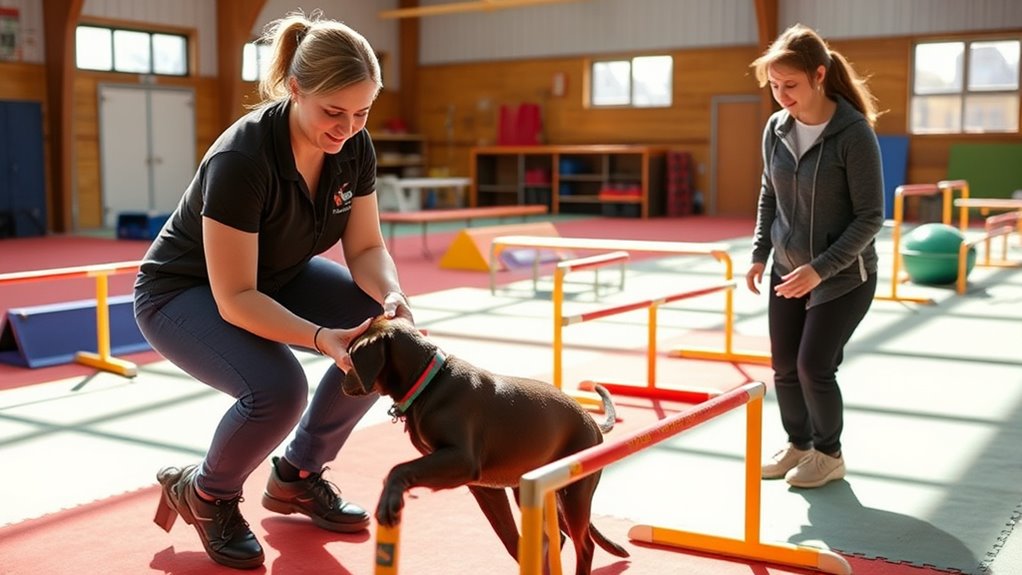Training guide dogs for deafblind partners involves a detailed process where you’ll learn to navigate busy urban environments confidently and safely. Your dog develops skills like obstacle avoidance, responding to commands amid distractions, and recognizing hazards. Emotional support and bonding are key, helping build trust and independence. You’ll access resources and techniques to strengthen your partnership. To discover the full journey and what’s involved, continue exploring how trainers prepare dogs for this essential role.
Key Takeaways
- Training combines navigation skills with specialized communication methods to accommodate both visual and auditory impairments.
- Dogs learn to recognize and respond to specific tactile and visual cues from their deafblind partners.
- The process emphasizes building a strong bond, trust, and understanding through consistent, patient training techniques.
- Trainers use simulated environments and real-world scenarios to ensure dogs can handle complex urban and social settings.
- Ongoing reinforcement and socialization are essential for maintaining skills and adapting to the unique needs of deafblind partners.

Training guide dogs for deafblind partners requires a specialized and dedicated approach that addresses both hearing and vision impairments. As you commence on this journey, you’ll find that these dogs need to master a unique set of skills to support you effectively in urban environments. City streets, crowded sidewalks, busy intersections, and public transportation all pose challenges that demand a highly responsive and adaptable guide dog. You’ll work closely with trainers to guarantee your dog can navigate these settings safely, avoiding obstacles, stopping at curbs, and recognizing hazards. The urban landscape is dynamic, so your dog needs to be attuned to constant changes, from moving vehicles to unexpected crowds, providing you with a reliable sense of security.
Guide dogs for deafblind individuals adapt to busy urban environments, ensuring safety and confidence amid constant change.
Beyond navigation, emotional support plays a fundamental role in the training process. Your guide dog isn’t just a helper; they become an essential source of comfort and companionship. As you face the stresses of daily life, your dog learns to read your emotional cues and offer reassurance when you’re anxious or overwhelmed. This emotional connection enhances your independence, allowing you to venture into challenging environments with confidence. Trainers emphasize socialization not just for practical skills but also to foster a strong bond between you and your dog. This bond is indispensable for trust, especially when you’re navigating unfamiliar or overwhelming situations.
The training process involves systematic exercises to reinforce obedience, focus, and situational awareness. You’ll participate in sessions where your dog learns to respond promptly to commands, even amidst distractions common in urban settings like sirens, shouting, or loud traffic. Consistent reinforcement helps your guide dog stay centered on your needs, guaranteeing that they can manage multiple stimuli without losing focus. During this phase, trainers also teach your dog how to recognize specific signals from you, such as when you’re feeling anxious or need reassurance, which further enhances their role as emotional support.
Additionally, best training guides provide invaluable resources and techniques that can supplement your training and deepen your understanding of your dog’s behavior, making your partnership even stronger. Throughout the training, patience and communication are key. You’ll learn how to give clear cues and how to interpret your dog’s signals. The process is about building a partnership rooted in mutual understanding, trust, and responsiveness. As your guide dog becomes more proficient, you’ll notice a marked increase in your ability to navigate urban environments safely and confidently while benefiting from the emotional stability that your dog provides. This extensive training guarantees that your guide dog is prepared to support you physically and emotionally, empowering you to live more independently and comfortably in the world around you.
Frequently Asked Questions
How Long Does Guide Dog Training Typically Take?
You might wonder how long guide dog training takes. Typically, the training timeline spans about 18 to 24 months, depending on the dog’s progress. During this period, highly qualified trainers work closely with the dogs, ensuring they develop essential skills. Their trainer qualifications assure they understand how to nurture and assess each dog’s readiness. This thorough process guarantees your future guide dog is well-prepared to assist you effectively.
What Breeds Are Best Suited for Deafblind Partners?
When choosing a breed for deafblind partners, focus on breed suitability and temperament traits. You’ll find that Labrador Retrievers and Golden Retrievers are ideal because of their friendly nature, intelligence, and adaptability. These breeds are known for their calm demeanor, trainability, and strong bond-forming ability. Such qualities make them excellent companions for deafblind individuals, ensuring safety, comfort, and effective assistance throughout their partnership.
Can Guide Dogs Be Trained for Specific Medical Alerts?
Imagine your guide dog sporting a tiny stethoscope, ready to alert you to medical emergencies—sounds like a superhero, right? Well, they can be trained for medical alerts through specialized cue training and medical alert training. You’d be surprised how adaptable these dogs are, recognizing subtle signs and alerting you promptly. It’s a remarkable blend of service and superhero skills, making your daily life safer and more manageable.
What Is the Cost Associated With Training a Guide Dog?
You might wonder about the cost of training a guide dog, which involves significant financial expenses. The total can range from $20,000 to $60,000, depending on the program. Funding sources like nonprofit organizations, government grants, and donations help cover these costs. Remember, investing in a guide dog provides invaluable independence and safety for your deafblind partner, making the financial commitment worthwhile.
How Do Guide Dogs Adapt to Different Environments?
Guide dogs adapt to different environments through environmental navigation and sensory adaptation. As you navigate new settings, your guide dog uses its training to recognize cues and adjust its behavior accordingly. It sharpens its senses to detect obstacles and changes in terrain, helping you move safely. This ongoing adaptability guarantees you can confidently explore various environments, knowing your guide dog is attuned to your needs and the surroundings.
Conclusion
Now you know the dedicated, detailed process behind training guide dogs for deafblind partners. From first familiarization to final finesse, each step strengthens the special bond between handler and helper. Remember, patience, persistence, and partnership power the path to independence. As you witness the wonderful work of these wise, well-trained dogs, you’ll appreciate the profound impact of compassionate training. Together, you and your guide dog will create a connection that conquers challenges and cultivates confidence.











